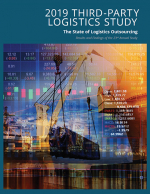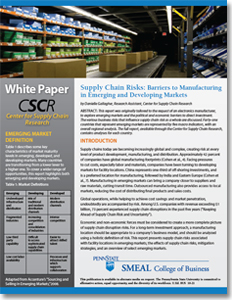Supply Chain Risks: Barriers to Manufacturing in Emerging and Developing Markets
Forty-one countries that represent emerging markets are represented by five macro indicators, with an overall regional analysis. The full report, available through the Center for Supply Chain Research, contains analyses for each country.
This report was originally tailored to the request of an electronics manufacturer, to explore emerging markets and the political and economic barriers to direct investment.
The various business risks that influence supply chain risk as a whole are discussed. Forty-one countries that represent emerging markets are represented by five macro indicators, with an overall regional analysis. The full report, available through the Center for Supply Chain Research, contains analyses for each country.
Introduction
Supply chains today are becoming increasingly global and complex, creating risk at every level of product development, manufacturing, and distribution.
Approximately 42 percent of companies have global manufacturing footprints (Cohen et al., 4). Facing pressures to cut costs, especially labor and materials, companies have been turning to developing
markets for facility locations.
China represents one-third of off-shoring investments, and is a preferred location for manufacturing, followed by India and Eastern Europe (Cohen et al., 7). Manufacturing in emerging markets can bring a company closer to suppliers and raw materials, cutting transit time.
Outsourced manufacturing also provides access to local markets, reducing the cost of distributing final products and sales costs.
Global operations, while helping to achieve cost savings and market penetration, undoubtedly are accompanied by risk. Among U.S. companies with revenue exceeding $1 billion, 73 percent experienced supply chain disruptions in the past five years (“Keeping Ahead of Supply Chain Risk and Uncertainty”).
What’s Related


Favorites





